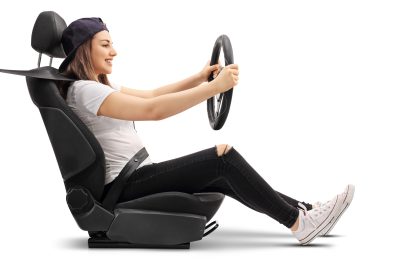Lower back pain while driving is a result of excessive lumbar flexion.
Doing this one thing will eliminate or at the very least decrease lower back pain while driving.
Car seats usually position the femur in too much flexion. This causes your lumbar spine to round out, compressing the lumbar disc. If you spend a considerable amount time commuting to and from work you need to get your car seat adjusted right.
Reducing the angle between your femur and your trunk will result in your lower back being positioned in a more neutral manner. This results in less compression through your lumbar discs.
Less compression through the discs translates to less pain.
This video shows you how to set up your seat to minimize pain causing forces through your lower back. Getting the seat in your car adjusted properly will result in less lower back pain while driving and throughout the course of your day. In addition the tissues in your lower back will be able to heal because driving every day won’t be aggravating them.

Don’t let driving contribute to your lower back pain. Get your car seat set up so the discs, joints, and muscles in your back have a fighting chance.
If sitting and driving increase back pain bending forward usually does too. Lower Back Pain When Bending Over walks you through how to make this movement pain-free.
FAQ
There are three primary variables you can manipulate to alleviate lower back pain while driving.
1. Seat position. The seat pan needs to be level or slightly tilted down. The seat back needs to be tilted back slightly, so the angle between your femur (upper leg) and torso is less than 90 degrees. Positioning the seat correctly reduces compression through the lumbar discs.
2. Sitting position. The best sitting posture is one that constantly changes. When you’re driving you need to be shifting weight from one cheek to the other. You should be leaning back, forward, and side to side. Making subtle shifts in your sitting position reduces constant low load through the lumbar tissues. These shifts don’t need to be dramatic, just subtle and frequent. Doing this minimizes force through one lumbar tissue, such as the discs or facet joints, and spreads it out. This will help reduce lower back pain while driving.
3. Time spent sitting and driving. Stopping and walking around every hour or two will reduce lower back pain while driving and keep your back from stiffening up too much.
First, you can get your seat positioned correctly. You don’t want your lumbar spine flexed too much. It needs to be in a more neutral position. This can be accomplished with making certain the angle between your femur and torso is less than 90 degrees. A lumbar support can also be used to maintain the natural lordotic.
Second, change sitting position often. Shift to the right, shift to the left. Lean forward, lean back, etc. The best sitting posture is one that changes constantly. These position changes are subtle and frequent. This promotes load sharing through the lumbar tissues, protecting them from excessive low load forces.
Third, stop and take a 5 minute break every couple hours. Walk around, reach up towards the sky and stretch. The body needs to get the hips extended and be in an upright position following long periods of sitting.
Applying these three principles will alleviate lower back pain while driving.
There are three primary variables you can manipulate to relieve lower back pain while driving.
1. Seat position. The seat pan needs to be level or slightly tilted down. The seat back needs to be tilted back slightly, so the angle between your femur (upper leg) and torso is less than 90 degrees. Positioning the seat correctly reduces compression through the lumbar discs.
2. Sitting position. The best sitting posture is one that constantly changes. When you’re driving you need to be shifting weight from one cheek to the other. You should be leaning back, forward, and side to side. Making subtle shifts in your sitting position reduces constant low load through the lumbar tissues. These shifts don’t need to be dramatic, just subtle and frequent. Doing this minimizes force through one lumbar tissue, such as the discs or facet joints, and spreads it out. This will help reduce lower back pain while driving.
3. Time spent sitting and driving. Stopping and walking around every hour or two will reduce lower back pain while driving and keep your back from stiffening up too much.
There are three primary variables you can manipulate to stop lower back pain while driving.
1. Seat position. The seat pan needs to be level or slightly tilted down. The seat back needs to be tilted back slightly, so the angle between your femur (upper leg) and torso is less than 90 degrees. Positioning the seat correctly reduces compression through the lumbar discs.
2. Sitting position. The best sitting posture is one that constantly changes. When you’re driving you need to be shifting weight from one cheek to the other. You should be leaning back, forward, and side to side. Making subtle shifts in your sitting position reduces constant low load through the lumbar tissues. These shifts don’t need to be dramatic, just subtle and frequent. Doing this minimizes force through one lumbar tissue, such as the discs or facet joints, and spreads it out. This will help reduce lower back pain while driving.
3. Time spent sitting and driving. Stopping and walking around every hour or two will reduce lower back pain while driving and keep your back from stiffening up too much.



